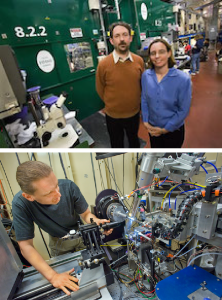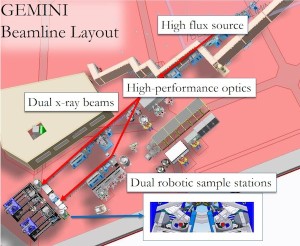 The Berkeley Center for Structural Biology (BCSB) has operated five beamlines at the Advanced Light Source (ALS) for more than ten years, helping hundreds of crystallographers to determine the structures of more than 1,000 proteins. Two of the BCSB’s beamlines (8.2.1 and 8.2.2) are funded by the Howard Hughes Medical Institute (HHMI) to support the cutting edge research of structural biologists, including those in the HHMI research community. To ensure that these crystallographers have access to state-of-the-art instrumentation and user support, HHMI has pledged $5 million to the BCSB over the next 3 years to construct a new cutting-edge microfocus macromolecular crystallography beamline.
The Berkeley Center for Structural Biology (BCSB) has operated five beamlines at the Advanced Light Source (ALS) for more than ten years, helping hundreds of crystallographers to determine the structures of more than 1,000 proteins. Two of the BCSB’s beamlines (8.2.1 and 8.2.2) are funded by the Howard Hughes Medical Institute (HHMI) to support the cutting edge research of structural biologists, including those in the HHMI research community. To ensure that these crystallographers have access to state-of-the-art instrumentation and user support, HHMI has pledged $5 million to the BCSB over the next 3 years to construct a new cutting-edge microfocus macromolecular crystallography beamline.

Paul Adams and Corie Ralston, who worked together to bring in the funding for the GEMINI project, in front of the current HHMI beamlines at the ALS (top). Simon Morton, the scientist who came up with the original idea for GEMINI, prepares to align an x-ray beam (bottom photo).
Working closely with the ALS, the BCSB has developed a plan for GEMINI, a vanguard beamline that provides the structural biology capabilities required by researchers in the coming decade. “GEMINI will have cutting-edge X-ray technology to increase flux and provide a smaller beam focus, as well as advanced automation for sample handling and high performance detectors for data collection,” said Corie Ralston, Head of the BCSB. “HHMI believes, as we do, that this system will be synergistic, exceeding the capability of any currently available structural biology beamline. This kind of project also highlights the interdisciplinary collaborations made possible by the environment at Berkeley Lab. We have access to an extremely talented pool of people with different backgrounds and areas of expertise: Peter Zwart and Simon Morton (Physical Biosciences), Chuck Swenson (Engineering), and Christoph Steier (Accelerator and Fusion Research), to name just a few, who have formed a first-class team working together toward a common goal.”
Hundreds of users access the HHMI beamlines every year, solving high impact challenging problems. One of these discoveries has been made recently by HHMI investigator Jennifer Doudna, Faculty Biochemist in the Physical Biosciences Division, and Professor of Molecular and Cell Biology at UC Berkeley. Doudna used the BCSB beamlines, as well as ALS beamline 8.3.1, to solve the structure of Cas9, lending insight into the CRISPR/Cas9 system. As a result of this increased structural understanding, this bacterial genetic editing system is revolutionizing the field of molecular biology and gaining wide use in a variety of fields.
Some of the most challenging projects in structural biology today involve the study of membrane proteins, receptors, and large protein complexes. While characterizing these systems at a structural level is crucial to understanding their function, these proteins typically yield very small, weakly diffracting crystals. “Progress is being made to study these crystals using free electron lasers, but these are early days for this technology and the experiments are still difficult to perform,” said Paul Adams, Deputy Director of the Physical Biosciences Division and Division Deputy for Biosciences at the Advanced Light Source. Adams is an x-ray crystallographer who has been involved in free electron laser experiments, and he spoke of the opportunity GEMINI provides. “GEMINI helps address the need for solving structures from these challenging systems without resorting to an FEL.”
This transformation of the crystallography experiment is made possible by three major factors. First, development of technology for synchrotron beamlines has resulted in devices that deliver high power “off the shelf” components.

GEMINI brings together the latest technologies in x-ray optics, detectors, and precision sample handlers in one facility.
The combination of these new technologies with the experience and expertise of the ALS staff means that on-line real-time beam focusing can be realized, so that the spot size and shape can be focused to the exact size of each crystal. Second, GEMINI leverages two robotic sample mounters in a coordinated system that will bring sample exchange times down to seconds, making it home to the world’s fastest sample mounter. Third, technological advances in x-ray detectors now make it possible to collect data sets in minutes or seconds, with better signal-to-noise than the best CCD detectors currently available. Together, these advances will enable centering, rastering, and data collection from every sample within seconds or minutes. With GEMINI, sample exchange and data collection will be so fast that screening and data collection converge. Every crystal – no matter how small or poorly diffracting – can be evaluated and data collected.
The total cost for GEMINI is $10M over a period of three years. Already, the BCSB has secured a commitment of additional funding from industry partners, and several other organizations have expressed their interest. In addition, Berkeley Lab management recognizes the importance of this project to the mission of the Lab, and has committed resources for the infrastructure changes in the ALS ring required to accommodate GEMINI.
GEMINI evolved from the BCSB’s extensive experience with x-ray optics, automation and outstanding operational support. HHMI’s support for this project will help BCSB advance its vision, expertise and service and aid in providing the advanced technologies needed by structural biologists now and in the coming years.



